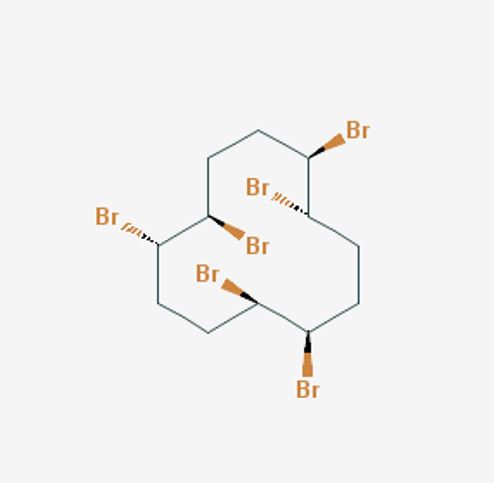SedimentHBCD (µg/kg dry weight)
|
MusselsHBCD (µg/kg wet weight)
|
|
|---|---|---|
|
|
North |
|
| South |
What is it?
Hexabromocyclododecane (HBCD) is a brominated flame retardant, used primarily in polystyrene foams for thermal insulation in the construction industry. HBCD is also used as a flame retardant on upholsteries, wall coverings, and draperies.1 HBCD is not known to be manufactured in Canada, but is still in use.

How does it get into the ocean?
The major pathways by which brominated flame retardants enter the marine environment are likely landfill runoff and leaching from finished products into wastewater systems.
Like other flame retardants, HBCD is persistent and bioaccumulates in food webs.2 However, while regulations appear to have resulted in decreasing concentrations of other flame retardants such as PBDEs3,4, HBCD concentrations may be increasing in the environment.5
Is it a problem?
Brominated flame retardants as a group are known to have toxic effects to immune, thyroid, reproductive, and neurological systems in terrestrial and aquatic organisms.7,8
In rats, HBCD exposure has been shown to cause increases in liver weight and changes to the thyroid system 9, while in mice, HBCD exposure caused developmental neurotoxicity.10
FACT: HBCD concentrations increased exponentially in the eggs of rhinoceros auklets, Leach’s storm-petrels, and ancient murrelets between 1990 and 2011.6 Low levels of HBCD were also detected in the eggs of cormorants and herons in British Columbia starting in 2003.3
What is being done?
In 2016, HBCD was added to Canada’s Toxic Substances Regulations. As of January 1, 2017, the manufacture, use, sale, and import of HBCD, as well as building and construction materials containing HBCD were prohibited in Canada.11 In 2016, the European Union also prohibited the manufacture, use, and sale of HBCD.
Canadian Federal Environmental Quality Guidelines (FEQGs) have been developed for HBCD in sediment for the protection of all forms of aquatic life, including sediment-dwelling and pelagic animals (Table 1).12 These guidelines have also been adopted as British Columbia Working Water Quality Guidelines.16 FEQGs have also been developed for tissues of aquatic biota that are protective of mammalian wildlife consumers.
Table 1. Federal Environmental Quality Guidelines and Provincial Marine Guidelines for HBCD 12, 16
What can we do?
As individuals and organizations, we can:
- Learn more about HBCD and other brominated flame retardants using the resource links below
- Recycle and dispose of waste responsibly and according to local guidelines
- Avoid using products that contain HBCD and other contaminants of concern. The US EPA’s Safer Choice program identifies products that are safer for humans and the environment and can be used as a reference to check product ingredients.13,14 The Green Science Policy Institute also provides information regarding consumer choices.15
More information?
1 Environment and Climate Change Canada (ECCC) and Health Canada. 2011. Screening Assessment Report on Hexabromocyclododecane. Chemical Abstracts Service Registry Number 3194-55-6. 121 pp. Available at: PROTECTED: B
2 de Wit CA. 2002. An overview of brominated flame retardants in the environment. Chemosphere 46: 583-624.
3 Miller A, Elliott JE, Elliott KH, Guigueno MF, Wilson LK, Lee S, Idrissi A. 2015. Brominated flame retardant trends in aquatic birds from the Salish Sea region of the west coast of North America, including a mini-review of recent trends in marine and estuarine birds. Science of the Total Environment 502: 60-69.
4 Ross PS, Noël M, Lambourn D, Dangerfield N, Calalmbokidis J, Jeffries S. 2013. Declining concentrations of persistent PCBs, PBDEs, PCDEs, and PCNs in harbor seals (Phoca vitulina) from the Salish Sea. Progress in Oceanography 115: 160-170.
5 Covaci A, Gerecke AC, Law RJ, Voorspoels S, Kohler M, Heeb NV, Leslie H, Allchin CR, de Boer J. 2006. Hexabromocyclododecanes (HBCDs) in the environment and humans: a review. Environmental Science and Technology 40: 3679-3688.
6 Miller A, Elliott JE, Elliott KH, Guigueno MF, Wilson LK, Lee S, Idrissi A. 2014. Spatial and temporal trends in brominated flame retardants in seabirds from the Pacific coast of Canada. Environmental Pollution 195: 48-55.
7 de Wit CA, Herzke D, Vorkamp K. 2010. Brominated flame retardants in the Arctic environment – trends and new candidates. Science of the Total Environment 408: 2885-2918.
8 Letcher RJ, Ove Bustnes J, Dietz R, Jenssen BM, Jorgensen EH, Sonne C, Verreault J, Vijayan MM, Gabrielsen GW. 2010. Exposure and effects assessment of persistent organohalogen contaminants in arctic wildlife and fish. Science of the Total Environment. 408(15): 2995-3043.
9 van der Ven LTM, Verhoef A, van de Kuil T, Slob W, Leonards PEG, Visser TJ, Hamers T, Herlin M, Håkansson H, Olausson H, Piersma AH, Vos JG. 2006. A 28-day oral dose toxicity study enhanced to detect endocrine effects of hexabromocyclododecane in Wistar rats. Toxicological Sciences 94: 281-292.
10 Eriksson P, Fischer C, Wallin M, Jakobsson E, Fredriksson A. 2006. Impaired behaviour, learning and memory, in adult mice neonatally exposed to hexabromocyclododecane (HBCDD). Environmental Toxicology and Pharmacology 21: 317-322.
11 Environment and Climate Change Canada (ECCC). 2016a. Current Regulations: Regulations Amending the Prohibition of Certain Toxic Substances Regulations, 2012 (for the addition of 5 substances) (SOR/2016-252). Available at: Substance prohibition summary: hexabromocyclododecane – Canada.ca
12 Environment and Climate Change Canada (ECCC). 2016b. Canadian Environmental Protection Act, 1999. Federal Environmental Quality Guidelines: Hexabromocyclododecane (HBCD). Available at: Environment and Climate Change Canada – Federal Environmental Quality Guidelines Hexabromocyclododecane (HBCD)
13 United States Environmental Protection Agency (US EPA). 2018. Safer Choice. Available at: https://www.epa.gov/saferchoice
14 United States Environmental Protection Agency (US EPA). 2014. Flame Retardant Alternatives for Hexabromocyclododecane (HBCD). Available at: https://www.epa.gov/sites/production/files/2014-06/documents/hbcd_report.pdf
15 Green Science Policy Institute. 2017. Flame Retardants. Available at: http://www.sixclasses.org/videos/flame-retardants
16 British Columbia Ministry of Environment and Climate Change Strategy. 2021. Working Water Quality Guidelines: Aquatic Life, Wildlife & Agriculture. Water Quality Guideline Series, WQG-08. Prov. B.C., Victoria B.C. Available at: bc_env_working_water_quality_guidelines.pdf (gov.bc.ca)